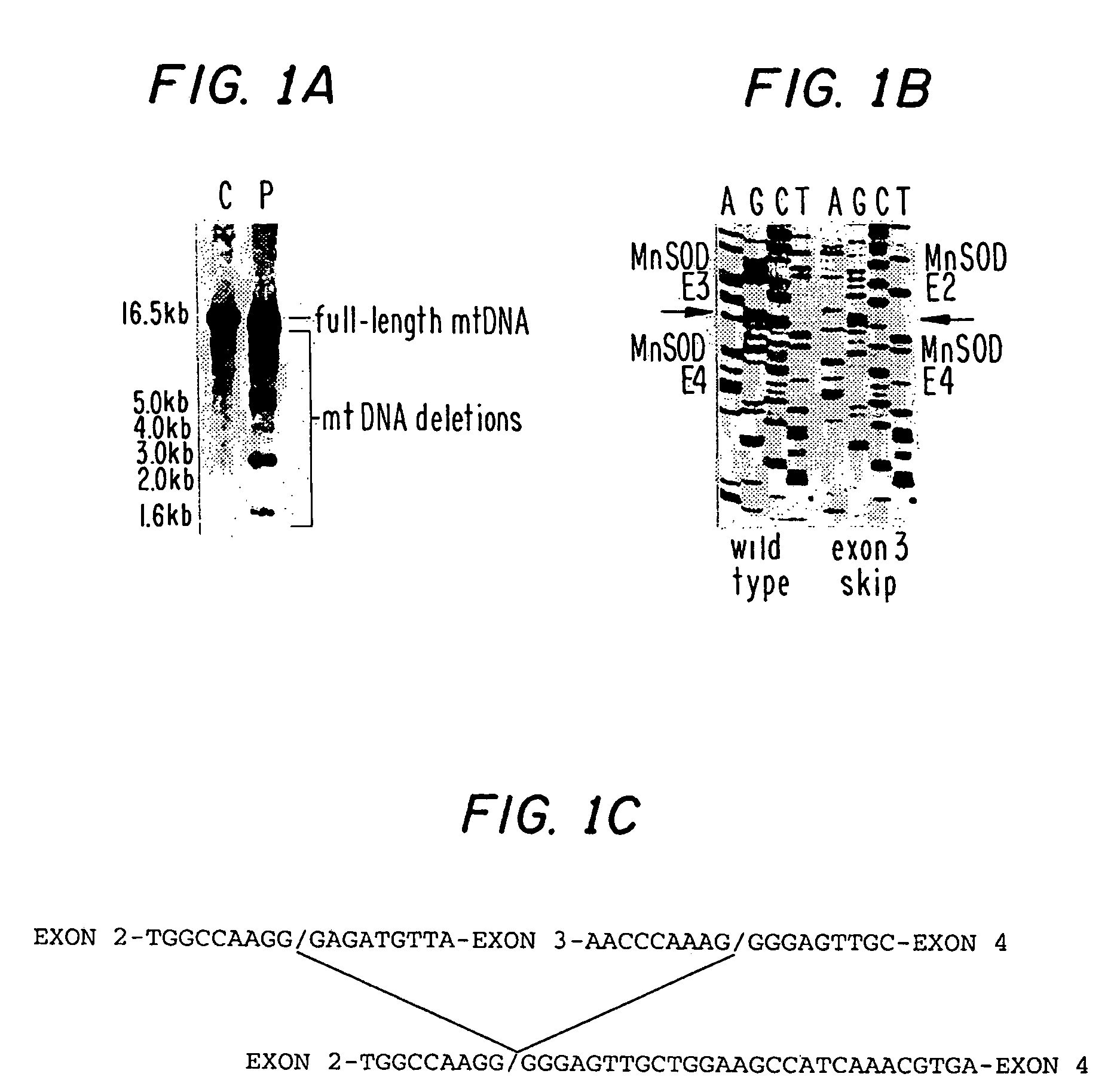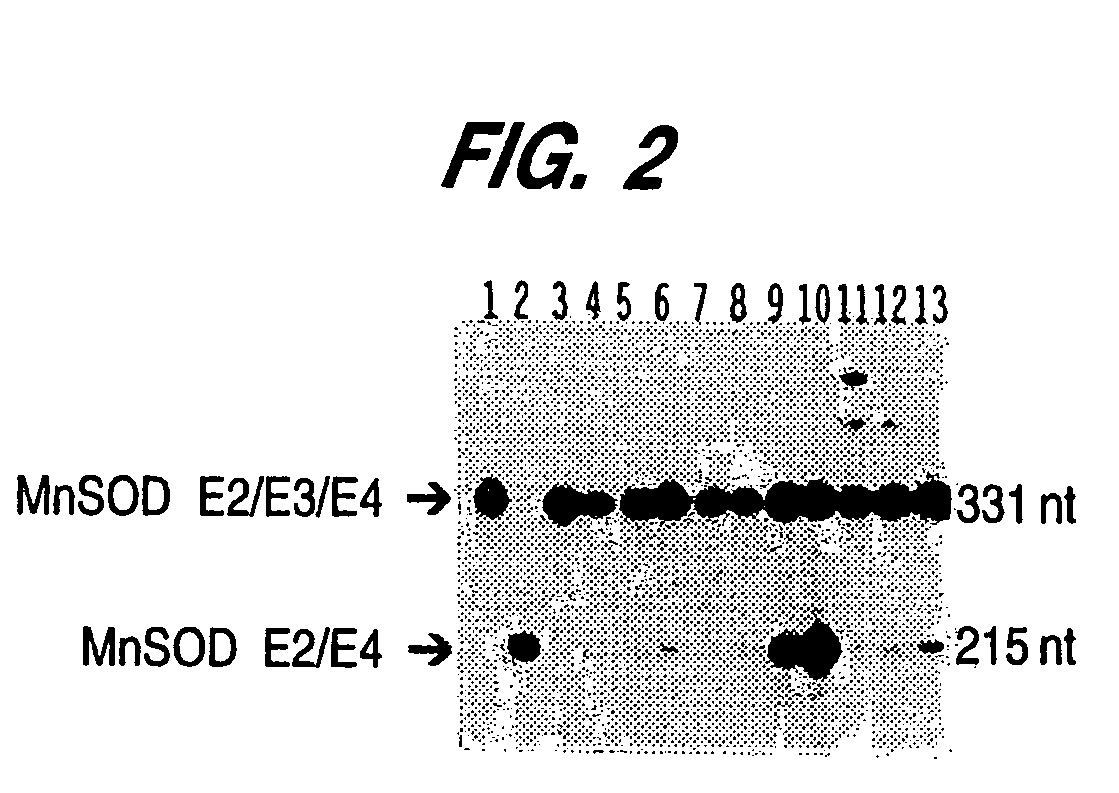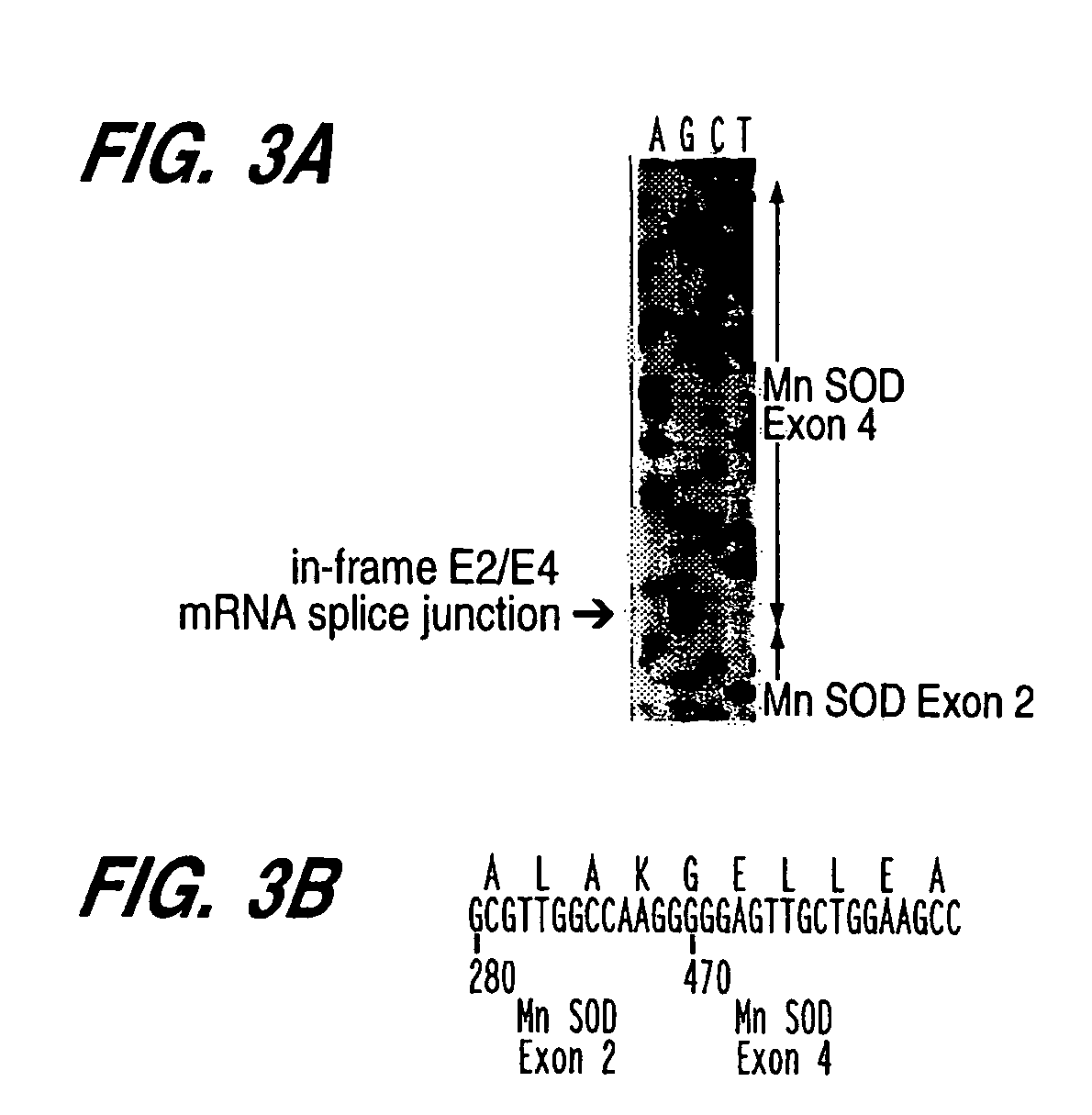Manganese superoxide dismutase exon 3-deleted isoforms and nucleic acid molecules encoding the isoforms
a technology of manganese superoxide dismutase and exon 3 isoform, which is applied in the direction of enzymology, organic chemistry, peptide/protein ingredients, etc., can solve the problems of oxidative damage to a wide variety of macromolecules and cellular components, protein and lipid peroxidation, and oxidative damage to the mtdna
- Summary
- Abstract
- Description
- Claims
- Application Information
AI Technical Summary
Benefits of technology
Problems solved by technology
Method used
Image
Examples
example 1
Identification of a Novel MnSOD E3 (−) mRNA Splice Variant Associated with Multiple mtDNA Deletions
[0119]MnSOD mRNA transcripts from the PMBC of a patient with mild anemia, mild leukopenia and multiple mtDNA deletions in his PMBC were initially analyzed by cloning reverse transcriptase / polymerase chain reaction (RT / PCR) products. Cells were isolated from 10 ml of freshly isolated blood (“purple-top” EDTA vacutainer tube) using Lymphocyte Separation Medium (Pharmacia). Washed cells were lysed by the TriZol method (GIBCO / BRL). Total RNA was then re-extracted with acidic phenol and alcohol precipitated. cDNA was prepared using M-MLV reverse transcriptase (BRL) and oligo dT.
[0120]Nested PCR was used in order to obtain a more effective amplification. Two PCR rounds were performed: MnSOD primer pair #1: Exon-1-forward: 5′-AGCCAGCTCTAGAAGCATGTTGAG (SEQ ID NO:5), Exon-5-reverse: 5′-ATTCTGCAGTACTCTAGACCACTAC (SEQ ID NO:6); nested 2nd primer pair: Exon-2-for: 5′-GCTCTAGAACCTCACATCAAC (SEQ ID ...
example 2
In Vitro Expression of the cDNA of the MnSOD E3(−) Splice Variant and Its Effect on mtDNA and Nuclear DNA Degradation
[0124]The effect on the genomic structure of cellular DNA by expression of the cDNA encoding the E3(−) MnSOD isoform was examined using the tet-off mammalian gene expression system (Clontech).
[0125]Transient transfection of HEK293 tet-off cells with the full length, antioxidant-MnSOD or the MnSOD E3(−) cDNA are shown in FIGS. 5A and 5B. Both cDNAs are driven by the tetracycline / doxycycline-regulated transcription factor (Clontech). HEK293 tet-off cells were grown in DMEM / 5% FBS with 20 ng / ml doxycycline and then electroporated with 1 mg recombinant plasmid per 108 cells. Electroporated cells were split into four 60 mm plates and grown for 30 hrs in the same medium. The medium in each plate was replaced with DMEM / 5% FBS with either 20 ng / ml, 2.0 ng / ml, 0.2 ng / ml, 0.02 ng / ml doxycycline. Cell growth was continued for 24 hours to allow expression of the transfected cDNA....
example 3
Preparation and Use of Polyclonal Antiserum Containing Anti-MnSOD E3(−) Antibodies
Antibody Preparation
[0131]A polyclonal antibody was raised in rabbits using the peptide sequence: NH2-(GlyCys)-GlnGluAlaLeuAlaLysGlyGluLeuLeuGluAla (vendor: BioSynthesis, Inc. Project #: BSYN 617,618. The N-terminal GlyCys are not MnSOD-encoded sequence, and are part of this peptide sequence for technical reasons).
[0132]Antibodies were prepared according to the following protocol:
[0133]The animals used were two New Zealand White Females, approximately 12 weeks of age, 2 kg of weight. Two (2) antigen-adjuvants compositions were used. For primary injection, (1:1) 200 ug of conjugated peptide (˜0.5 ml of conjugate solution) plus equal amount of Freund's complete adjuvant was used. For booster injection, (1:1) 200 ug of conjugated peptide (˜0.5 ml of conjugate solution) plus equal amount of Freund's incomplete adjuvant was used. Animals were inoculated according the following schedule:
[0134]
AMOUNTS / VOLUMES...
PUM
| Property | Measurement | Unit |
|---|---|---|
| weight | aaaaa | aaaaa |
| nucleic acid | aaaaa | aaaaa |
| oxidative stress | aaaaa | aaaaa |
Abstract
Description
Claims
Application Information
 Login to View More
Login to View More - R&D
- Intellectual Property
- Life Sciences
- Materials
- Tech Scout
- Unparalleled Data Quality
- Higher Quality Content
- 60% Fewer Hallucinations
Browse by: Latest US Patents, China's latest patents, Technical Efficacy Thesaurus, Application Domain, Technology Topic, Popular Technical Reports.
© 2025 PatSnap. All rights reserved.Legal|Privacy policy|Modern Slavery Act Transparency Statement|Sitemap|About US| Contact US: help@patsnap.com



